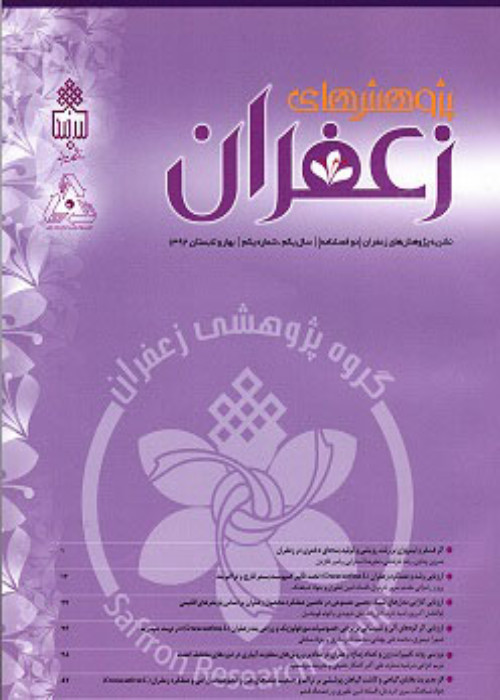Evaluation of Allelopathic and Antifungal Effects of Saffron (Crocus sativus L.) Leaves and Corm Extracts on Wild Mustard and Alternaria sp.
Author(s):
Article Type:
Research/Original Article (بدون رتبه معتبر)
Abstract:
Introduction
Saffron is obtained from the dried red stigmas of Crocus sativus L., an autumnal herbaceous flowering plant belonging to the Iridaceae family. It is largely cultivated in Iran, India, Afghanistan, Greece, Morocco, Spain and Italy. Due to the increase of crop living stresses and side effects of chemical pesticides, recent investigations have been conducted to study herbicidal and fungicidal potential of medicinal plant such as Saffron. Saffron is one of the plants, whose allelopathic effect on various organs has been reported to affect the seed germination of some weed species. It is well known that saffron leaves and corms produce bioactive compounds. Some of these compounds have a role in the inhibition of plant growth and seed germination in their vicinity. The present research was conducted with the aim of evaluating the allelopathic and antifungal effect of extraction solution of leaves and corms of saffron (Crocus sativus) on wild mustard and Alternaria sp.Materials and Methods
To evaluate the allelopathic and fungicidal effect of saffron leaf and corm extracts on the germination and growth characteristics wild mustard and Alternaria sp., independent factorial experiments were conducted as factorial arrangement based on the completely randomized design with four replications at the Faculty of Agriculture of Birjand University in 2022. Treatments to test the inhibitory effect of the saffron extract on weed seed germination characteristics included two types of saffron organs (leaf and corm) and seven extract concentrations (0, 0.25, 0.5, 1, 1.5, 2, and 4 w/v %). Experimental treatments to investigate the inhibitory effect of saffron extract on the growth of Alternaria sp. fungus included two types of saffron organs (leaf and corm) and seven extract concentrations (0, 1, 0.5, 25. 0, 0.125, 0.625, and 0.0312 w/v %). The measured and calculated traits included germination percentage, germination rate, mean germination time, radicle length and weight, plumule length and weight, seedling weight and seed vigor, and wild mustard allometric coefficient, as well as the growth rate of fungi colonies.Results and Discussion
The results showed that the type of extract has an effect on germination rate, mean germination time, radicle length and weight, shoot length and weight, seedling weight, seedling vigor, and allocation coefficient of wild mustard were significant, and the corm extract had more negative effects compared to the leaf extract. By increasing extract concentration; its effectiveness also increased as by increasing extract concentration to 4 % significant decrease in the length and weight of the radicle, the length and weight of the shoot, the weight and the length plumule of the wild mustard seedling compared to the control. The results of the interaction effect of the type of extract and the concentration of the extract on the growth characteristics of the wild mustard primary seedling showed that the lowest root length, fresh and dry weight of the root, stem length and fresh and dry weight of the stem, the weight of the seedling and the root of the plant related to the concentration of 4 % root extract. 75.2, 68.7, 68.4, 68.7, 75.2, 75.4, 73.5, and 72.3 percent decrease compared to the control, respectively, while the reduction values of root length, fresh weight and root dry weight, stem length and stem wet and dry weight, seedling weight and seedling stem in the case of leaf extract are 48.2, 46.7, 44, 48, 48.8, 46.8, 47.4 and 47 respectively. It was a percentage. The results of the interaction effect of the treatments showed that on the ninth and twelve days, concentrations of 0.125, 0.25, 0.5, and 1% of corm extract and 1% concentration of leaf extract inhibited 100% of Alternaria fungus growth.Conclusion
Finally, the results of these experiments showed that the effect of inhibiting the germination and growth of wild mustard as well as the antifungal effect is greater in saffron corm extract than in leaf extract. Therefore, considering the results of this research and conducting more research in the field of allelopathic and fungicidal effects of saffron organ extracts, we can proceed to produce natural herbicides and fungicides.Keywords:
Language:
Persian
Published:
Journal of Saffron Research, Volume:11 Issue: 2, 2023
Pages:
221 to 235
magiran.com/p2684549
دانلود و مطالعه متن این مقاله با یکی از روشهای زیر امکان پذیر است:
اشتراک شخصی
با عضویت و پرداخت آنلاین حق اشتراک یکساله به مبلغ 1,390,000ريال میتوانید 70 عنوان مطلب دانلود کنید!
اشتراک سازمانی
به کتابخانه دانشگاه یا محل کار خود پیشنهاد کنید تا اشتراک سازمانی این پایگاه را برای دسترسی نامحدود همه کاربران به متن مطالب تهیه نمایند!
توجه!
- حق عضویت دریافتی صرف حمایت از نشریات عضو و نگهداری، تکمیل و توسعه مگیران میشود.
- پرداخت حق اشتراک و دانلود مقالات اجازه بازنشر آن در سایر رسانههای چاپی و دیجیتال را به کاربر نمیدهد.
In order to view content subscription is required
Personal subscription
Subscribe magiran.com for 70 € euros via PayPal and download 70 articles during a year.
Organization subscription
Please contact us to subscribe your university or library for unlimited access!


